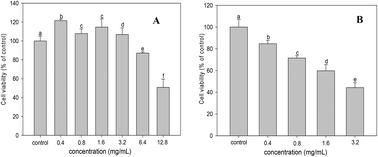Stachyose-induced apoptosis of Caco-2 cells via the caspase-dependent mitochondrial pathway
Abstract
Some studies have shown that stachyose, as prebiotics, can prevent indirectly colon cancer cell growth by promoting the proliferation of probiotics or producing beneficial materials in the intestine. However, its direct inhibitory effects on cancer cells are still unclear. Thus, this study aims to investigate the direct inhibitory effect of stachyose on human colon cancer cells and determine the molecular mechanism underlying this effect. The MTT assay was used to assess the inhibitory effect of stachyose on Caco-2 cells. Apoptosis and mitochondrial membrane potential (ΔΨm) measurements were analyzed using flow cytometry. The activities and mRNA expressions of caspases 3 and 9 were determined using caspase assay kits and quantitative real-time polymerase chain reaction. The apoptotic protein expressions of Bcl-2, Bax, and cytochrome C (Cyt C) were detected through western blotting. Results showed that stachyose inhibits Caco-2 cell proliferation and induces apoptosis in a dose-dependent manner. After pretreatment with 0.4, 0.8, 1.6 and 3.2 mg mL−1 stachyose, cell inhibitory rates of 15.31% ± 3.20%, 28.45% ± 2.10%, 40.23% ± 5.70%, and 55.67% ± 4.50% were respectively obtained. Compared with the control, decreases in ΔΨm, increases in caspase 3 and 9 activities and mRNA expressions, down-regulation of Bcl-2 protein expression, up-regulation of the Bax protein and Cyt C release of Caco-2 cells were clearly observed upon exposure to different stachyose concentrations. The inhibitory mechanism of stachyose on Caco-2 cells involves the caspase-dependent mitochondrial apoptosis pathway.


 Please wait while we load your content...
Please wait while we load your content...